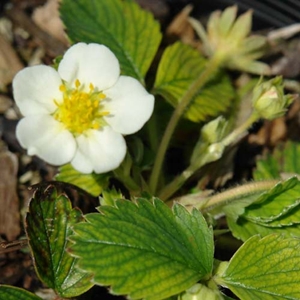Reprinted courtesy of All Season Plants
So, you know the modern garden strawberry Fragaria ananassa. It’s a hybrid. Well, it just so happens that our very own native strawberry – Fragaria chiloensis, a.k.a. the beach strawberry – was one of the two species which combined to create it! That’s right: our coastal strawberry helped give the world those famously sweet, big summer berries.
Photo courtesy of All Season Plants
We actually prefer the native version. It doesn’t even wait for summer. Beach Strawberry starts producing flowers and fruit in, oh, about ten minutes from now. It’s also pretty to look at, a groundcover with glossy dark leaves and fresh white blossoms peeping out.
Just plant it in full sun, where it can pretend it’s home on the grassy bluffs of the coast. A little shade is okay, and don’t worry, from zones 5b to 9b, it can take the cold. Once established, it’ll start sending out horizontal, non-invasive runners, while producing big red berries.
Oh, and because it’s an evergreen perennial, you won’t have to worry about bare spots in your garden come winter – it’ll still be there.
Also from the All Season Plants website: This spreading perennial makes an excellent ground cover. White flowers from March through August become edible red fruits. Prefers full sun if it’s close to water or part shade inland. Native to coastal bluffs and sand dunes in the Pacifice Northwest. Cold tolerant to at least 15 degrees. Likes well-drained, acidic soils. Maximum height: 4 inches.
Beach Strawberry

